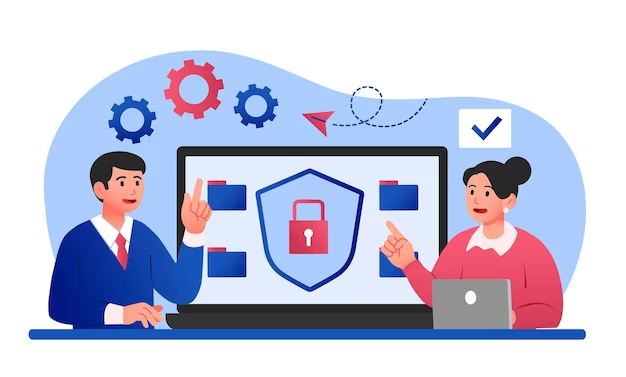The rise of remote work has transformed how businesses operate, offering increased flexibility and access to a global talent pool. However, new challenges have emerged with this shift, particularly in cybersecurity.
In this blog, we will explore the cybersecurity risks that remote teams face and provide practical strategies to protect your business from potential threats.
Understanding Cybersecurity Risks for Remote Teams
Phishing Attacks
One of the most common cybersecurity risks for remote teams is phishing attacks. Cybercriminals send fraudulent emails, messages, or links that appear legitimate, tricking employees into revealing sensitive information or installing malicious software on their devices. These attacks can lead to data breaches, financial losses, and reputational damage.
To mitigate this risk, businesses must educate their remote teams about the dangers of phishing attacks. Regular training and awareness programs can help employees recognize phishing attempts and avoid falling victim to them. Implementing robust email filtering and verification systems can also help identify and quarantine phishing emails before they reach the inbox.
Unsecured Wi-Fi Networks
Remote workers often connect to public Wi-Fi networks, which could be more secure. Cybercriminals can intercept data transmitted over these networks, leading to data theft and unauthorized access to corporate systems. This risk is particularly high when remote employees use unsecured public Wi-Fi for sensitive tasks like accessing company databases or emails.
To safeguard against this threat, remote teams should use virtual private networks (VPNs) to encrypt their internet connections. VPNs create a secure tunnel for data transmission, making it extremely difficult for hackers to intercept or decipher the data. Encouraging employees to avoid public Wi-Fi for work-related tasks whenever possible can reduce the risk.
Weak Passwords
Weak or easily guessable passwords are a common vulnerability that cybercriminals exploit to gain unauthorized access to remote team members’ accounts and devices. Remote employees may be inclined to use simple passwords, especially when managing multiple accounts, making it easier for attackers to crack them.
Businesses should enforce strict password policies, requiring employees to create and change complex passwords regularly. Implementing two-factor authentication (2FA) or multi-factor authentication (MFA) can add a layer of security. Password manager tools can also help employees generate and store strong passwords securely.
Inadequate Endpoint Security
Endpoint security is a critical concern in the remote work landscape. Endpoints like laptops and smartphones are often the entry points for cyberattacks. Remote team members’ devices can be compromised without proper security measures, leading to data breaches and system vulnerabilities.
To protect against inadequate endpoint security, businesses should provide remote employees with security software, firewalls, and antivirus tools. Regularly updating and patching software is essential to address vulnerabilities. Companies should also establish clear policies for remote device management, ensuring that all devices used for work are correctly secured.
Insider Threats
While remote work has many advantages, it also presents the risk of insider threats. Employees with access to sensitive company information may misuse or leak data intentionally or inadvertently. It poses a considerable challenge for businesses aiming to protect their digital assets.
Organizations can implement robust access controls and monitor employee activities. Clear policies and employee training can foster a security culture, encouraging remote team members to report suspicious activities. Conducting regular audits and restricting access to sensitive data on a need-to-know basis can further reduce the risk of insider threats.
Shadow IT
Shadow IT refers to using unauthorized and unmonitored software and applications by remote employees. While employees may adopt these tools with good intentions, they can introduce security vulnerabilities into the organization. With proper oversight, it becomes easier for businesses to ensure the security of their data and systems.
To address the risk of shadow IT, businesses should maintain clear policies on software usage and conduct regular audits to identify unauthorized tools. Encouraging remote teams to consult with the IT department before implementing new software can help ensure that security considerations are taken into account.
Data Encryption
Data encryption protects sensitive information from unauthorized access, particularly for remote teams. Even if data is intercepted, encrypted data is virtually unreadable without the appropriate decryption key. Failure to implement encryption can expose businesses to the risk of data breaches and compliance violations.
To safeguard against this risk, businesses should ensure that all sensitive data is encrypted in transit and at rest. Using encryption tools for emails, file storage, and communication applications can provide an additional layer of security.
Lack of Security Updates
Failure to apply security updates and patches to software and systems is a significant risk for remote teams. Cybercriminals often target known vulnerabilities that remain unpatched, making it essential to keep all software up to date.
Remote employees should be encouraged to enable automatic updates on their devices to mitigate this risk. Businesses should also maintain a schedule for regular security updates and patches. Organizations can reduce their exposure to cyber threats by staying proactive in addressing known vulnerabilities.
Protecting Your Business: Practical Strategies
Establish Clear Cybersecurity Policies
Businesses should create and communicate clear cybersecurity policies to remote teams. These policies should outline best practices for securing data, using company devices, and identifying potential threats. Regular training and reminders can help reinforce these policies.
Invest in Security Software
Investing in reputable security software, such as antivirus programs, firewalls, and endpoint security solutions, can provide extra protection for remote teams.
Implement a VPN Solution
Encourage using VPNs to encrypt internet connections and protect sensitive data when employees are working remotely. Guide on selecting and using VPNs effectively.
Conduct Regular Security Awareness Training
Regularly educate remote employees about the latest cybersecurity threats and how to recognize them. This training should cover phishing attacks, strong password practices, and avoiding shadow IT.
Monitor and Audit Remote Device Usage
Implement monitoring and auditing mechanisms to keep track of remote device usage. It can help identify any unauthorized or suspicious activities.
Enforce a Strong Password Policy
Enforce strict password policies, including strong, unique passwords and regular password changes. Consider implementing two-factor or multi-factor authentication for added security.
Encrypt Sensitive Data
Ensure all sensitive data is encrypted in transit and at rest. Implement encryption tools for remote teams’ email, file storage, and communication applications.
Regularly Update and Patch Software
Establish a regular schedule for applying security updates and patches to all software and systems used by remote employees.
Conclusion
In the rapidly growing realm of remote work, safeguarding your business from cybersecurity threats is more crucial than ever. Understanding remote teams’ diverse challenges and implementing practical strategies are key to ensuring a secure work environment. Clear policies, investments in security measures, and ongoing education for remote employees all play pivotal roles in mitigating risks effectively.
As we navigate the dynamic landscape of remote work, especially where seamless communication is vital, consider enhancing your security framework by integrating a call monitoring system. This addition provides an extra layer of security by allowing businesses to proactively monitor and analyze communication channels, particularly during voice communications. This proactive approach enables your organization to swiftly identify and address potential security threats, contributing to a more robust cybersecurity posture.






